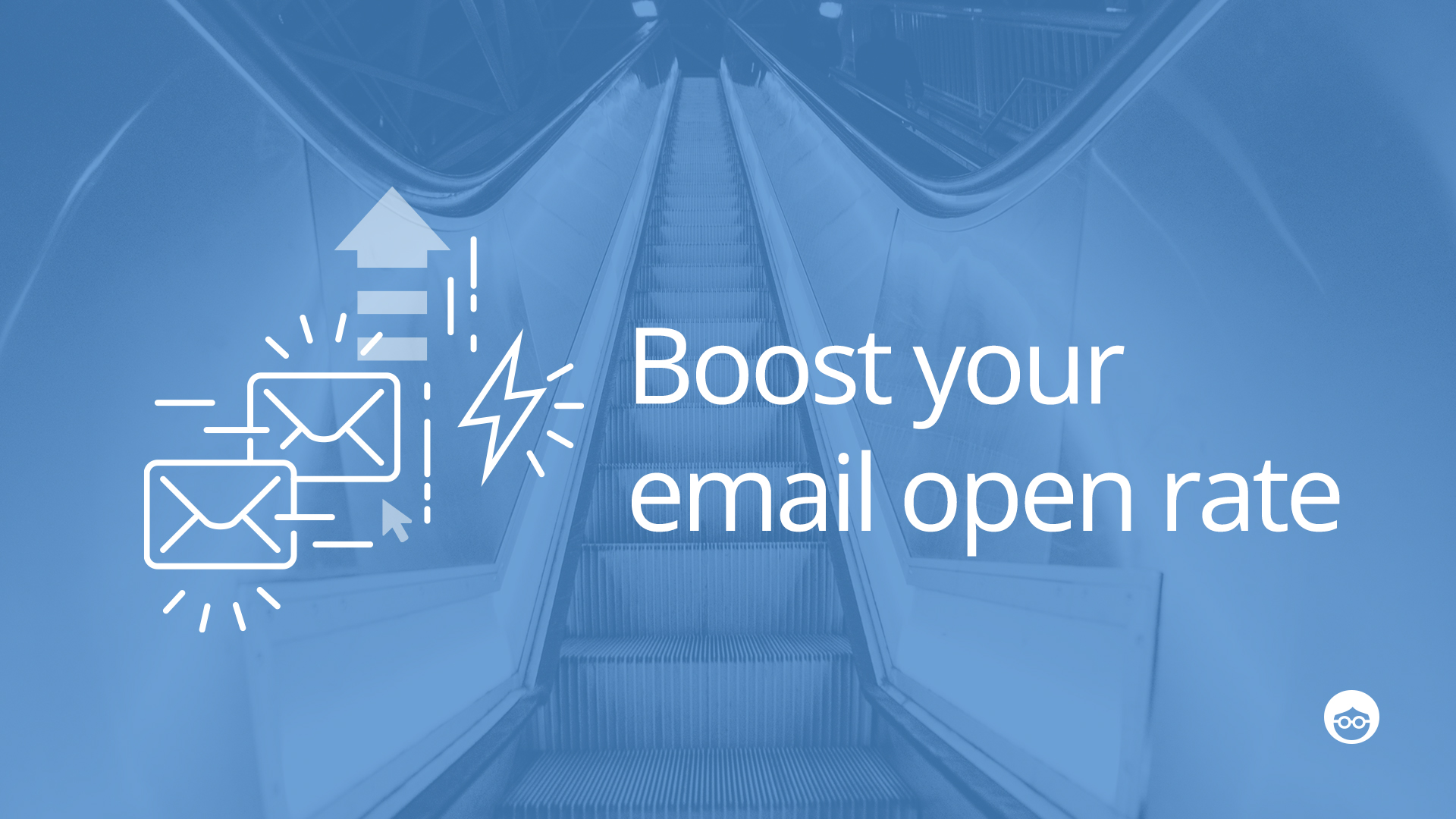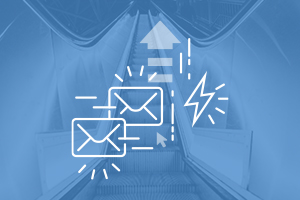How To Write B2B Subject Lines That Convert

Before you even start dreaming about conversions, you have to be noticed. And that means getting people to click on your emails.
Catching your prospects’ attention as they check their inbox is half the email marketing battle. Of all the B2B email elements, the subject line is a small step for your recipients that will bring a huge leap for your sales.
The subject line is the potential start of a new customer relationship – or a deeper relationship with existing customers. This is why there is such an emphasis on the importance of subject lines in email marketing, and why you should continue working on them until they are flawless.
Of course, the very words “flawless subject line” are a tad overwhelming. What can you really achieve in one short subject line? How can you get it to perform in the best possible way? Should you use numbers? When shouldn’t you use numbers?
To help you out, we’ve curated a set of tips that will help you enrich your subject lines and make them your trusty conversion tool. Feel free to use them whenever you can, and advance your open rate to a new level:
- Season your emails
- Tailor your templates
- Don’t make it about you
- Don’t make false promises
- Show ‘em what you’ve got
- Use relationships
- Use numbers (with caution)
- Don’t be a salesperson
- Less is more
- Test everything!
1. Season your emails
Your recipients don’t live in a vacuum. They have top-of-mind concerns that are connected to the particular characteristics of their industry, like seasonality. Recognizing the importance of seasons will display your knowledge and expertise of your prospects’ vertical and your intent to take care of their needs. Here are some examples of seasonal subject lines:
“Your strategy for Q2”
This shows that you’re well aware of the business concerns of your target audience and you are ready to work in sync with their plans.
“Seamless month closing with {YourCompany}”
This is a good way to show how much you prioritize the goals of your recipients, and it also touches a major pain point – meeting monthly deadlines.
“Hot season at {Company}”
Every company has one – an intense period in the working cycle which strains the company’s resources. A subject line like this will show you understand the challenges they face, and this will be appreciated by the recipient. It may even motivate them to respond.
After working with over 100 companies, we can confirm that targeted prospects are highly responsive to time-based subject lines. This approach may increase the probability of closing a deal, because if you reach out when your prospects are defining their budget, it is easier to carve a neat spot just for your offering.
2. Tailor your templates
Nothing kills the morning mood like opening your inbox and seeing a bunch of almost-identical subject lines. It’s enough to make you bulk mark them for deletion…
On the other hand, nothing is more refreshing than a really compelling subject line that looks like a personal message, not a generic advertisement. Instant click!
Here’s a few tips about how to personalize your subject lines:
Know your audience
In good B2B email marketing, there is no such thing as “one size fits all”. What worked for one prospect, won’t necessarily work for others. Different people have different priorities and pain points.
Don’t settle for just one sales template, and perhaps avoid using basic templates at all. Create different emails for different customer personas, and adjust them for specific clients and prospects.
Follow the rhythm
Your recipients are busy and productive. They have accomplishments, receive rewards, attend events, and perform a lot of other praiseworthy activities. Naturally, they would appreciate some recognition. Especially, in their inbox.
“Saw you at [EventName]”
This subject line can be used if you attended the same event as your prospects. It’s a great way to tentatively reach out and start a business relationship.
“To the winner of [ContestName]”
This shows your familiarity with the events that are relevant to the recipient’s vertical, as well as your genuine interest in your prospect’s achievements.The information about your prospect’s company winning an award or getting certified can be located very easily (social media, press releases , etc), and mentioning it in the subject line will show how attentive you are.
“Comments on your progress, {Name}”
This type of subject line works perfectly for recipients who have recently distributed a press release or submitted a public document showcasing their increase in revenue or any other accomplishment. It will signal your will to go beyond generic greetings, and show that you are indeed more attentive to details than your competitors are.
3. Don’t make it about you
The best way to “win friends and influence people”, as the famous book states, is to let them talk. You want your prospects to share their biggest pain points with you. Therefore, you should invite them to start a conversation. Give the spotlight to your prospects, their interests, goals, and concerns, instead of putting the focus on your product or brand.
Here are some examples of how this might play out in subject lines:
“{Name}, let me know what you think”
This is a trust-building subject line that shows your prospects that you are interested in what they have to say and respect their opinion.
“{Name} how would you rate your {pain point}?”
This shows you’re interested in the problems your prospects experience, making them more eager to open up and start a conversation.
“{Company}’s annual goals”
With this subject line, you make your prospects’ objectives a centerpiece of your campaign. This indicates that you’re keen on focusing on their goals and aspirations.
Provide your prospects with avenues for self-disclosure. They do want to tell about their struggles and victories, and when they get a signal that they can go ahead and start communicating, you’re already halfway to building a strong relationship.
4. Don’t make false promises
Don’t make promises that you cannot keep. Subject lines such as “Boost your sales in 3 days” or “Reimagine your business with [BrandName]” are well-known credibility destroyers in the world of B2B email marketing. If this is your first email to the prospect, it’s your chance at a first impression. Tread smoothly and follow basic etiquette rather than knocking the door down with advertising promises, before your recipients even know who you really are and what your service is all about.
If you want to hint at your product’s utility, do it with caution. Don’t go overboard with boring superlatives.
5. Show ‘em what you’ve got
Your prospects are not interested in your product. They’re interested in what your product can do for them. At the moment of meeting your prospects, your only chance to get them interested is to show how your offering can help solve their problem.
Summarizing your solution and stating your advantages early – even in your subject line – can help boost your credibility and your open rates.
6. Use relationships
Opinions matter, especially in the world of modern consumers. It’s not uncommon for buyers to consult with online reviews or recommendations before making a buying decision. 92% of consumers say they trust recommendations from friends and family rather than your advertising message.
This is a key way that consumers control and filter their options when navigating through the abundance of similar products and services online. This pattern of behavior is called “social proof” and it’s based on people relying on each other when it comes to figuring out the best way to respond and act in a certain situation. This type of response is particularly common for millennials and Gen X.
So, what do you do? Some companies pay YouTubers to promote their product; others invest in user-generated content. However, in the world of B2B, building relationships can be even simpler. B2B marketers already have a list of clients in their vertical, and many would be glad to connect you with some of their partners.
It’s a good way to warm up your introduction and inject social proof into your emails with subject lines like:
“[Referral Name] referred me to you”
This subject line builds trust because it is based on a common relationship (of course, make sure to get permission first!)
“[Referral Name] from [Company] suggested we speak”
Adding specifics increases your credibility and gives prospects a better picture of where you’re coming from. Therefore, your email is more likely to get opened.
“Suggestion from [Referral Name]”
This subject line may look tricky, but it has been proven to pique the curiosity of many a prospect. This may even lead them to open and read the email.
7. Use numbers (with caution)
Using numbers is always a “Do I? Don’t I?” question. On the one hand, numbers provide the clarity and certainty that help you stand out from the rest. On the other hand, using lots of numbers in the subject line can trigger spam filters, which might end badly for your domain reputation and deliverability. How do you avoid this?
- Indicate time
“{Name}, how about a 10-minute call?”
“Your schedule for this Tuesday?”
“Meeting for September 19th?”
Using numbers to ask for an appointment is a great way to add more specifics to your subject line without sounding sales-y or pushy. Instead, it will make your assertiveness look positive and organized.
- Provide proof
“Close month at 1⁄4 cost of the in-house team”
“Complete budgeting cycle 75% faster”
Using these subject lines can be a gamble with spam filters, but when done wisely, it piques your prospect’s curiosity and boosts your open rate.
- Avoid anything with 100% in it
Users are tired of this fanciful number, so it’s often an instant spam trigger.
- Move away from billions/millions/etc.
Unless you are Apple, it’s quite likely that you don’t have billions of people enjoying your product. Steer clear.
- 50% is not the way to go
Whether it’s “50% off” or “up to 50%”, nobody is falling for that anymore and spam filters are well aware of it.
- #1 – no way
TOP 1, Number 1 – we recommend avoiding them all. Everyone wants to be “the first”, and who doesn’t want to work with the “Number One” brand in the industry? But when everyone in your inbox is Number 1, then nobody is.
8. Don’t be a salesperson
It is very easy to fall into the trap of writing sales-y subject lines. Therefore, your prospects are already receiving tons of sales messages with catchy slogans, loud CTAs, and punchlines. There are two reasons why you should not follow the majority:
Safety: Generic messages create a lack of certainty regarding how and why the sender found you – and this already reduces the credibility of sales emails. Given how many times cybercriminals have been exploiting sales messaging, it’s no surprise that prospects may perceive a sales-y email with a link or an attached file as a security breach waiting to happen.
Spam threat: Lots of words and phrases that are supposed to be sales-generating are now considered spam triggers. No matter how hard you worked on your subject line, no matter how naturally words like “free”, “check it out” or “now” flow with the rest of the message, your email may end up in a spam folder, never reaching your prospects.
This is why, when you craft your subject line, instead of asking yourself, “How do I make my product look good?”, ask this:
“How do I make myself look credible?”
“How do I build trust?”
Make sure to choose language that emphasizes your credibility and assures readers that you are the real thing. Take time to re-read and check your subject lines for any spam triggers. If you’re unsure, you can take a look at HubSpot’s list of spam triggers for a wide range of verticals, and see if there are any words you have been using lately.
Ultimately, this will prevent apprehension among your prospects, and hopefully you’ll see an upsurge in your open rates.
9. Less is more
This tip isn’t going to reinvent the wheel, but it’s a fundamental principle that applies to subject lines as much as anything. The attention span of today’s consumers is dwarfed by the volumes of information coursing through our inboxes every day, so we have to adapt by instantly scanning the content, picking out any relevant bits (if there are any) and moving on.
The best thing any brand can do is to facilitate this process by presenting short, relevant information – in fact,the recommended length for subject lines is 4-7 words. Anything above this limit will break readability, more so because people often check their email via smartphones and tablets. If they can’t read and comprehend your subject line on the first try, they’re not going to get much further with your email.
10. Test everything!
This is not just another tip – it’s an absolute must for creating subject lines. It takes not one, but many strategies to nail your B2B marketing. Even companies within the same vertical require an individual approach to convert their prospects to customers. For this reason, you should make A/B testing a standard practice for all your email campaigns.
- Create two versions of a subject line and monitor the results. If you are appealing to a large industry, you can even make three or four versions to test more options.
- Pick the subject line that works best for your current prospects and use it as the basis for your next campaign.
- Take every piece of data into account, from positive responses to negative replies. It will help you determine what went wrong and what should be improved.
Repeat this every time you launch a new campaign. Each testing and monitoring session delivers new data that can enhance your strategy and provide you with a solid platform for your outreach.
In digital marketing, it’s the small things that can make the biggest difference. The email subject line – a modest 4 to 7 words long – punches above its weight in terms of its potential to boost your open rate and improve your email marketing results. So make sure to consider the tips and suggestions above to create the best possible subject lines for your B2B prospects.











